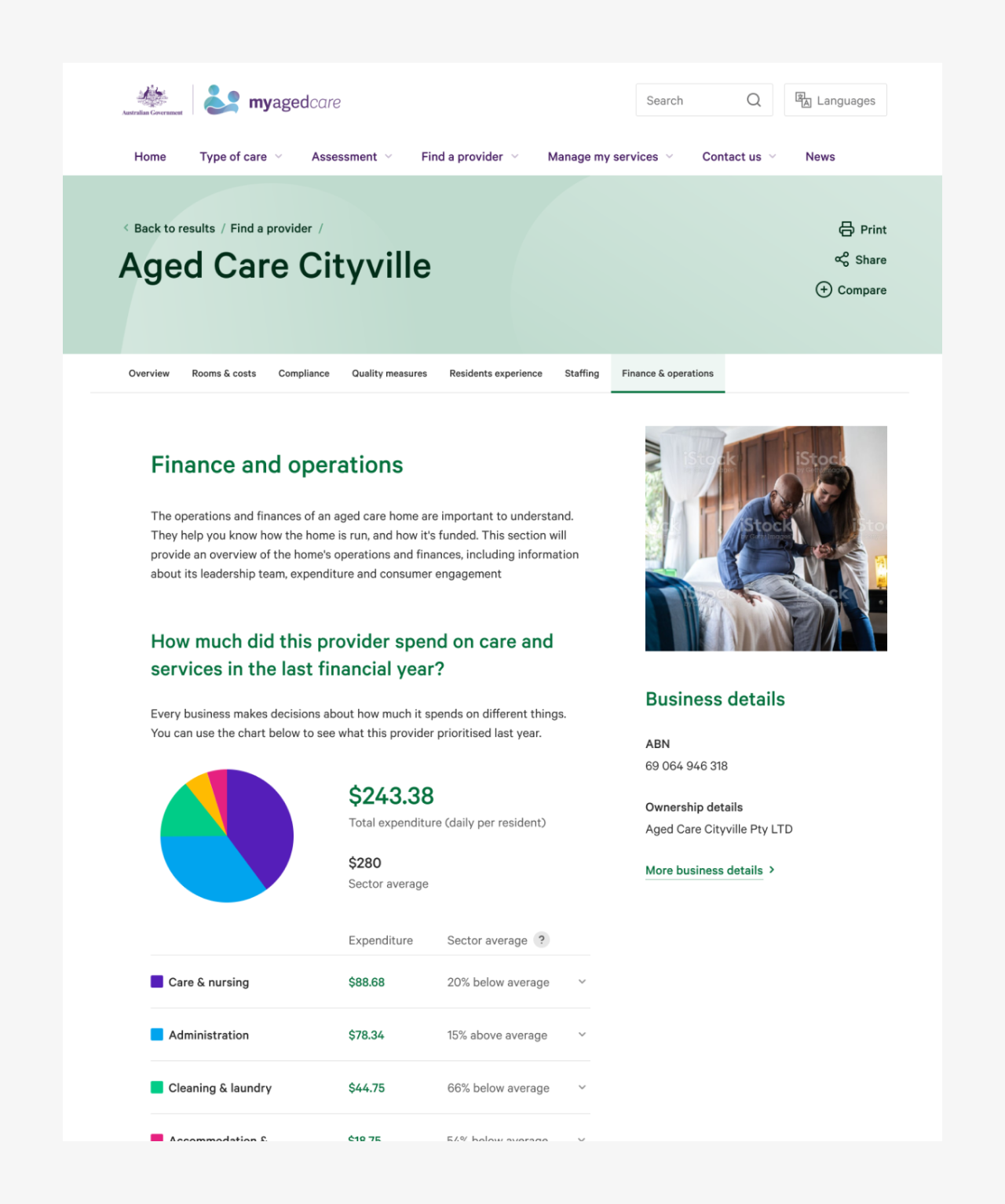Choosing an aged care provider is a big decision. To make an informed choice, it helps to know how providers operate and manage their finances. This data, along with other sources of information such as Star Ratings, can help you learn more about providers you’re interested in.
The government has introduced the ‘Dollars to Care’ measure, which holds aged care providers to account for how they manage their expenses, income, and budget. This information has been added to the profiles of providers of aged care homes and providers of Home Care Packages.
You can use this information to compare providers and help decide the one that best suits your needs, as well as prepare questions to ask providers if something isn’t clear or if you want to know more.
Financial information can sometimes be unfamiliar or hard to interpret. This page explains the new financial information aged care providers display in the Find a provider tool and what it means for you.
Provider finance and operations
What do I do with this information?
What do all the different terms mean?
How accurate is the financial information in Find a provider?
Where can I go for more information?
Provider finance and operations
As part of the new Dollars to Care measure, all government-funded aged care providers need to report information to the Australian Government about their operations and how they manage their money. You can use the Find a provider tool to see what providers have reported spending on care, staffing, food, and other expenses. This information is available in the Finance and operations section on providers’ profile pages.
This section appears on the profiles of providers of aged care homes and providers of Home Care Packages.

'Finance and operations' section in an aged care home's Find a provider profile
What do I do with this information?
Financial and operational information can help you learn more about a provider and decide if they are right for you. It's best to use this information along with other sources, as financial information can sometimes be misleading or difficult to interpret on its own. A few examples are included below:
Food and catering
You might look at how much an aged care provider spends on food and catering and compare that to other providers’ spending. Expenditure on food could point to its quality, but it doesn’t always tell you if the food is tasty or nutritious.
If a provider spends more or less than others, you might want to find out more by looking at other information in the Find a provider tool. For example, some aged care homes include sample menus in their profiles. You could also look at data in the residents’ experience surveys, which can tell you if the residents like the food. You also have the option to visit the aged care home and ask to see or try a meal.
Care
You might also look at how much a provider spends on care and compare that to other providers' spending. It is important to note that the amount spent will not necessarily tell you about the quality of care delivered by a provider. How much is spent on care can be influenced by many factors, including the location of the provider (whether they are remote or not) and the type of residents they provide care for (in some aged care homes, the residents may have much higher care needs), among others.
If you are researching aged care providers for yourself or someone else, reading through the financial information is a good way to prepare for informed conversations. You should contact providers directly to ask questions and discuss your individual care needs.
Read more about what to consider when choosing a provider.
What do all the different terms mean?
While it can be helpful to see where a provider spends and earns money, knowing how to interpret the information is key to making informed aged care decisions. Learn more about the different terms in the Finance and operations section and what each one means for you.
Sector average
For aged care home providers, financial information can be compared to a ‘sector average’. This helps you understand how a provider’s spending or income compares to other providers in the residential aged care sector. On My Aged Care, the term 'sector average’ is used to refer to the 'sector median', which is a way of showing a typical value.
The median is the middle value among all providers when their values are ordered by size. As an example, choose 5 different providers to compare. If you sort their spending on care from lowest to highest, the sector median is the third number on the list — the provider with the third highest expenditure. There would then be two providers on the list spending lower than the median, and two providers spending higher.
What do ‘above average’ and ‘below average’ mean?
An aged care home provider’s finances may be above, below, or equal to the sector average (or median). However, many factors play a role in how much a provider spends or earns. It's best to get more information before making any decisions.
For instance, an aged care home provider who spends less than average on care and nursing might have residents with relatively lower care needs. It doesn’t necessarily mean the quality of care is lower than average.
Other common reasons for providers to spend more or less than the average, include:
- geographical location: a provider located in a rural or remote area may face higher costs than a city-based provider to deliver the same quality of care and services.
- provider size: a large provider that delivers many aged care services may be able to deliver services at lower cost than a small provider, while maintaining quality.
The percentage number (%) next to each category of income and expenditure tells you by how much a provider is above or below the sector average.
Surplus and deficit
Knowing if a provider’s budget was in surplus or deficit for the year gives you some insight into their financial position.
If a provider’s budget is in surplus, their income was greater than their expenses for the last reporting period.
If a provider’s budget is in deficit, their expenses were greater than their income.
Many providers report deficits or losses for some or all of their services. This doesn’t necessarily mean they have financial issues. For instance, a provider’s budget may be in deficit while they renovate or invest in new facilities, but then return to a surplus once completed.
Not-for-profit providers making a surplus
You might not expect a not-for-profit provider to make a budget surplus, but it does happen. However, any surplus must be allocated towards the delivery of care. These providers can also retain a surplus as profit as long as there is a genuine reason to do so, and that reason is clearly linked to their organisation’s purpose.
For example, a not-for-profit provider may retain their surplus:
- to fund a new project
- to fund a new building or infrastructure, or
- to help them accumulate a financial reserve so they remain sustainable.
Per resident per day
For aged care home providers, you’ll see income and expenditure figures on the provider’s finance page presented in ‘per resident per day’ terms. This allows for a like-for-like comparison of the finances of other providers, regardless of how many residents they serve.
Financial information will still differ for each provider as it is based on many factors. For example, one provider may spend more per resident per day on allied health. This could be because they have more residents requiring these services.
Wages for care staff
In the Find a provider tool, you can see the hourly minimum, average, and maximum wage rates a provider pays to their direct care workers. This includes Registered Nurses, Enrolled Nurses, and Personal Care/Home Care Workers.
Providers paying higher wages may be better able to attract in-demand care and nursing staff. However, there are other factors to consider. For instance, providers usually need to pay higher wages to attract staff in remote areas compared to urban areas.
How accurate is the financial information in Find a provider?
Financial information presented on My Aged Care is based on an average or a total for all people using that service. As a result, the figures won’t always match the actual costs or income associated with any specific person. The income providers receive from the government to deliver care varies based on the level of care each person needs as well as their own ability to contribute.
To find out what you can expect to contribute for an aged care home or Home Care Package, you can use the My Aged Care fee estimator.
My Aged Care providers are legally required to report their financial information to the government. This information must be signed off by a Board Member (or Key Personnel for Government providers). They do this quarterly and annually through the Quarterly Financial Report and the Aged Care Financial Report. You can find more information about these reports on the Department of Health and Aged Care website.
Note: Some of the data reporting to the government has only recently started, and many providers may still be updating their accounting systems. This may lead to minor adjustments to data over the coming quarters. The department will continue working with providers to improve the quality of the data.
Where can I go for more information?
There is lots of information on this website that can help you when you are considering aged care providers and services. Some useful links include:


